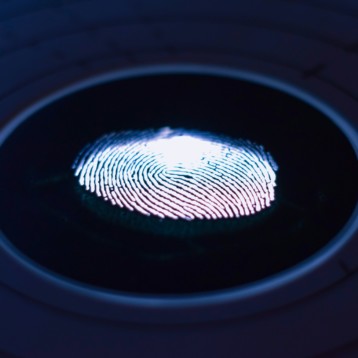|
Perhaps one of the most intriguing technologies introduced this year was computerized telekinesis. TFOT covered two companies, pioneers in the field, who have developed systems that monitor the electrical activity of the brain’s neurons and translate the data into distinguishable commands, which are transmitted to a computer. The California-based companies, “NeuroSky” and ”Emotiv”, combined their devices with video games in which the users could control their avatars and cause on-screen objects to levitate simply by thinking of doing so. In a simulation conducted on the “Harry Potter and the Goblet of Fire” game, players were connected to a set of electrodes, and were shown to ‘cast spells’ and ‘move’ on-screen objects using their brain. If all goes according to plan, we will be able to purchase these products already in 2008.
|
Over the past year, TFOT covered several groundbreaking technologies for data transmission applications. We covered the ongoing research at the Georgia Electronic Design Center (GEDC) at Georgia Tech, where scientists are exploring the possible uses of extremely high radio frequencies in order to achieve broad bandwidth and high data transmission rates over short distances. So far, the scientists have demonstrated astounding date transfer rates of up to 15 gigabits per second (Gbps) at a distance of 1 meter. Another innovative technology for efficient data transmission was introduced by the Amimon company. Their wireless high-definition interface enables wireless delivery of uncompressed HD audio and video files in real-time to a distance of up to 30 meters through walls, maintaining wire-equivalent quality and robustness.
|
Many new power generation techniques were covered by TFOT during 2007. One of these techniques is related to a new approach to wind-based energy generation that capitalizes on “vibrations”, making use of the physical “Aeroelastic Flutter” effect. The Aeroelastic flutter takes place when an electrical charge is created from oscillations that cause magnets to rotate between two metal coils. The British company “The Facility” developed a technology for converting the vibrations created by the mechanical movement associated with footsteps and transport into electrical power. During the next year, the company plans to test this technology in a building equipped with heel-strike generators, which will harvest kinetic energy released by people walking across the building’s floors. Another development related to converting kinetic energy into electric power was made by the Australian Commonwealth Scientific and Industrial Research Organization (CSIRO). CSIRO developed the flexible integrated energy device, which is a garment capable of charging electrical devices with the power generated by the wearer’s movements.
|
On the other side of the ocean, a team of researchers from MIT developed a technology for wireless power supply. The researchers demonstrated their technology by wirelessly lighting a 60watt light bulb from a distance of about 2 meters. However, Sony succeeded in developing the most surprising power generating device- a battery that generates electricity from sugar, which was designed according to the same power generation principles found in living organisms.
TFOT covered some of the most advanced tracking and surveillance techniques that were developed this year, such as the Xplorer shoe, which is equipped with a GPS and can be used to track missing people. Another notable achievement in this field was made by the Japanese giant Hitachi. The company managed to shrink a radio frequency identification (RFID) chip to the size of 0.15 x 0.15 millimeters, breaking the world record for this type of chips.
|
A team from Harvard University demonstrated a miniature 60-milligram robotic fly, the smallest of its kind. Harvard’s robotic fly has a 3-cm wingspanandis capable of sustained flight – holding great promise for military and intelligence applications. We also covered the Israeli TCUAV surveillance system, consisting of an unmanned overhead vision device that is connected to a “train” unit. The unit follows a wired path, transmitting a constant supply of electrical power to the aerial vehicle above.
This year we had the opportunity to catch a glimpse of the motor future at the 3rd DARPA Urban Challenge. The event demonstrated the latest developments in automotive systems. This time the gold medal was awarded to a team from the Carnegie Mellon University, whose driverless vehicle named “The Boss” successfully completed a series of tasks along the urban course and won the race. The vehicles that competed in the DARPA Challenge represent only some of the many attempts to develop reliable robots that could be used by the military to carry equipment and supplies across rough terrains and in dangerous areas without endangering the soldiers’ lives.
|
The U.S.-based robotic company Boston Dynamics developeda four legged robotic mule, named “BigDog”, precisely for such purposes. Their prototype managed to move at a speed of 3.3 mph (5.3 km/h), climb a 35 degree slope, and carry a 120 lb (54 kg) load. In fact, many of the technologies we covered this year were developed specifically for military applications. These include the WaterScout – a submarine deployable helicopter, and the world’s first laser-based weapon.
|
This year was far from being a disappointing one for the gadget-lovers among us. We wrote about ElekTex technology, which enables users to control displays integrated into various fabrics, such as laptop covers or bags. The system allows users to perform certain actions while a laptop inside the bag is in standby mode, i.e., without opening the laptop or turning it on. For example, users can listen to an MP3 player or browse a digital photo album using the bag’s surface alone. Now if you really want to stand out in public – wear a T-shirt capable of detecting Wi-Fi hotspots, and slide to work on the Airboard – a personal hovering scooter. Attention guaranteed. Another futuristic accessorycovered by TFOT this year was the Wheelsurf – a single-wheeled ride-inside vehicle, based on a rotating frame that rolls the device across various surfaces.
|
Things got even more exciting in the field of robotics – this year TFOT covered a number of extraordinary robots, such as the wall climbing Waalbot, Toyota’s violin-playing robot, and of course, the robotic soccer players, who competed in this year’s Robocup tournament. The German firm “Festo” presented a novel mechanical arm, developed using advanced techniques in automated movement. The so-called “Airic’s Arm” was created after a close study of the “design principles of nature”, and the scientists believe the model comes as close as possible to its human counterpart in terms of overall concept, technical design, and bionics. The Festo Company also created the “Air Ray” – a remote-controlled ballonet filled with helium and constructed with a flapping-wing drive mechanism, which allows it to “swim” freely in the air.
|
A hot topic this year was display technologies – from advanced projection systems and interactive screens to novel e-papers – we’ve seen it all. We wrote about the paper-like thermochromic display – a flexible display, which consists of a thermochromic composite that can change its color according to varying temperature levels, with embedded conductive wiring patterns. TFOT also covered an invention of the Toronto-based Opalux company- a new type of electronic ink, based on photonic P-ink crystals. Using the new technology, rich, high-quality colors can be displayed, something that previous display techniques had not enabled. TFOT also covered Planar Systems’ transparent and segment electroluminescent (TASEL) displays, which are based on an innovative technology. Planar Systems’ displays offer better transparency and allow the user to cut or form the display into a variety of shapes. We also wrote about “Paper 4”, an interactive paper developed by Swedish scientists. Paper 4 can change its display appearance and even play music in response to human touch.
|
Holographic displays have been at the center of attention this year, and TFOT covered some of the significant progress in the development of such systems throughout the year. Among others, TFOT covered a 360-degree holographic display developed by scientists at the University of Southern California, and a 3D holographic video system developed at MIT.
|
We also covered a number of interactive display technologies, which were revealed this year. PICO, an interactive tabletop surface, is capable of solving various optimization problems, which are defined by mechanical constraints created by the user on the projected surface. For example, this system is able to maintain an equilateral triangle constructed of three pucks placed on the table, by rearranging them when one or more of the pucks are relocated by the user. We wrote about Microsoft’s PlayAnywhere system, an interactive computer-vision system, which allows users to interact with a variety of physical and projected objects placed on flat surfaces. Another unique application that uses an interactive projection system was created by two students from MIT; their Audiopad is a tool for composing electronic music, which tracks the positions of objects on a tabletop surface and converts their motion into music.
|
In 2007 the limits of technology were pushed even further in terms of presenting innovative practical solutions to everyday problems. Thanks to the MIT Lecture Browser, the university’s students are now able to search online video lectures for specific words or phrases. “D-Wave Systems”, a Canadian Company, demonstrated what it claims to be the first practical and commercially viable 28-qubit quantum computer. The computer is able to carry out multiple calculations simultaneously, achieving faster computation results than conventional computers. Sony has introduced a novel CMOS (Complementary Metal-Oxide Semiconductor) image sensor which enables photographers to capture a quick series of high resolution still images at 60 frames per second during video recording. This device allows photographers to obtain high-quality individual images from video footage. Perhaps one of this year’s most important inventions was the “Life Saver” – a bottle installed with a mechanism capable of purifying even the dirtiest water, eliminating foul tastes and smells from the liquid within seconds.
And now for the really good news: in 2008 the Internet promises to become elitist! A team of American scientists have developed the “StupidFilter” – an open-source filter software that will detect and eliminate “rampant stupidity” of web-content in written English.
|
TFOT featured several in-depth articles about some of this year’s most interesting topics – we covered the DARPA Challenge as part of an article regarding the development of autonomous vehicles. In addition, we wrote about the future of electronic paper and a revolutionary new optical-storage technology called Memile, which will allow us to store up to 5 Terabyte worth of data on a single disk. The last article featured in TFOT in 2007 dealt with mind controlled bionic limbs – another invention, which like so many others, is immediately associated in our minds with some science fiction movie or book.























